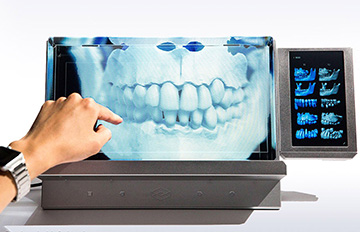
The Looking Glass desktop holographic display [Image: Looking Glass Factory]
Looking Glass Factory is a holography company with offices based in Brooklyn, N.Y., USA, and Hong Kong. Looking Glass CTO Alex Hornstein spoke with OPN about the various applications for the company’s holographic displays, which they demonstrated as part of the Science and Industry Showcase at FiO+LS 2019.
What does Looking Glass produce?
These are light-field displays. In short term, we call them holographic displays, and if your readers want to yell at us for that, then come at us!
Do you get a lot of people yelling at you?
There are a lot of old-school holographers who feel very strongly that holography is something that’s done with a laser and an interference pattern, but people said the same thing when digital photography showed up—that this is not real photography.
The way I see it is that holography is a way to capture and replay a light field. This is also a way to capture and replay a light field; we’re just using a completely different technique. But the end result and the concept we’re playing with is very similar.
I see a tabletop holographic image of a man dancing, and you can interact with him by waving your hand in front of the display. How does this work?
What’s going on here is, in virtual space we have this dancing guy, and this is a scene in a game engine that is meant for real-time interaction. The hand tracker in front of the display allows me to put a 3-D model of my hand into that same virtual space.
Every frame, 60 times a second, we render a light field in that virtual world. We do that by moving a virtual camera and capturing that scene from multiple perspectives. The display starts with an LCD display, and it has a lenticular lens array laminated on top. What that does is, it gives every pixel in that screen a direction. And we’re capturing, in this case, 45 views of a scene, and we’re rendering out those views in these different angles.
So everything we do as a company is around that process—how do I take something from virtual space and pull it into physical space.
What are some of the applications for these displays?
We launched these holographic displays over a year ago, and there are thousands of them out there right now in the hands of 3-D creators—from game designers to architects to researchers to volumetric filmmakers—people who work with 3-D across the spectrum.
One use is just simple visualization. Say I’m an architect and I’ve been working with my team on a scene design. We need to show that design to someone, a client, in a way that feels present and real. Perhaps we even need to change things in real time for a customer.
Plenty of architects use animated models for client presentations, or even a headset. But there are limits to what each of these can do. Headsets are very immersive, but only for one person at a time. In a group scenario, something that lets me move through a space and also collaborate with my team and the client at the same time—there’s something very powerful there.
You have a holographic display of a human heart. Are there medical applications for the Looking Glass?
Probably the largest source of 3-D data in the world is medical—think of PET scans, CAT scans, MRIs, etc. When a doctor looks at individual slices of a CAT scan, they’re mind is putting those slices together. They’re looking at a 2-D model and they’re creating a 3-D model in their head. That’s complicated.
Our approach is to visualize it first, holistically, and then analyze it. These models could also be used to explain things to patients in a way that they can visualize and understand.
What is the significance of having a tabletop AR/VR display like this, rather than a headset or other device?
The underlying idea is that we’re not putting on headgear, we’re interacting as two humans. But we also have this power of having a virtual world that doesn’t follow the rules of the physical world, and can have a wide set of different data-display and visualization options.
As the director our R&D lab, I like the idea of removing barriers and just having very natural 3-D interactions.
